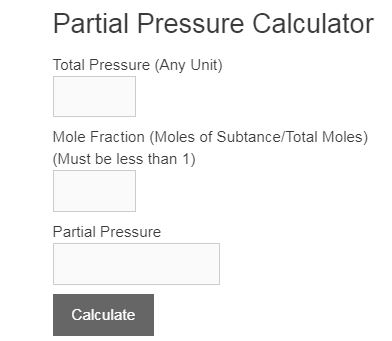Enter the total pressure and mole fraction of that substance to calculate the partial pressure. The partial pressure is calculated through the use of Dalton’s laws of partial pressure. This calculator can also determine the mole fraction or total pressure given the other values.
- All Pressure Calculators
- Ideal Gas Law Calculator
- Pressure Calculator
- Boyle’s Law Calculator
- Atmospheric Pressure Calculator
- Volume at Standard Temperature and Pressure Calculator
- Henry’s Law Constant Calculator
- Total Pressure Calculator
- Saturation Pressure Calculator
Partial Pressure Formula
The following formula is used by the calculator to evaluate the partial pressure of a substance.
PP = TP * Mole Fraction
- Where PP = partial pressure
- TP = total pressure
- Mole Fraction is the fraction of moles of substance (must be less than 1)
To calculate a partial pressure, multiply the total pressure by the mole fraction.
Partial pressures can also be calculated through the ideal gas law and both methods of Henry’s Law.
Partial Pressure Definition
Partial pressure is a term used to describe the portion of pressure that one specific substance exerts when examining an entire gas. Perhaps, we should take a step back. Pressure is a force applied equally over a surface. In the case of an ideal gas, the gas exerts an outward force on the surroundings.
The partial pressure is the force that 1 singular substance exerts out of the total force of the gas. In an ideal gas, it’s directly proportional to the moles of substance to the total moles. This means if we know the fraction of the moles of the substance to the total moles, we can simply multiply it by the total pressure to get the partial pressure.
How to calculate partial pressure?
The following example goes over how you determine the partial pressure of a substance in an ideal gas. Let’s assume that gas is comprised of 3 different substances, oxygen, nitrogen, and helium. We want to know the partial pressure that oxygen exerts compared to the total pressure.
- First, we must measure the total pressure. This can be done using several measurement devices, but for this example, we will assume we know it’s 200 psi.
- Next, we need to determine the mole fraction of oxygen to the total moles. We will say the breakdown is as follows, 200 moles – 200 moles – 200 moles, for all 3 substances. Therefore the mole fraction is 1/3.
- Finally, plug in all of the numbers into the equation above. PP = TP * 1/3 = 66.66 psi.
- Analyze the results and adjust the calculation.
As mentioned previously, the partial pressure can also be calculated through the use of the ideal gas law. Ideal gases are unique in that the pressure is directly proportional to volume, temperature, and number of moles. Therefore, if you simply enter the number of moles of your specific substance, and you know the volume and temperature of the entire gas, you can calculate the partial pressure.
FAQ
Partial pressure is a term used to describe the portion of pressure that one specific substance exerts when examining an entire gas.
For more science and engineering calculators, click here.
